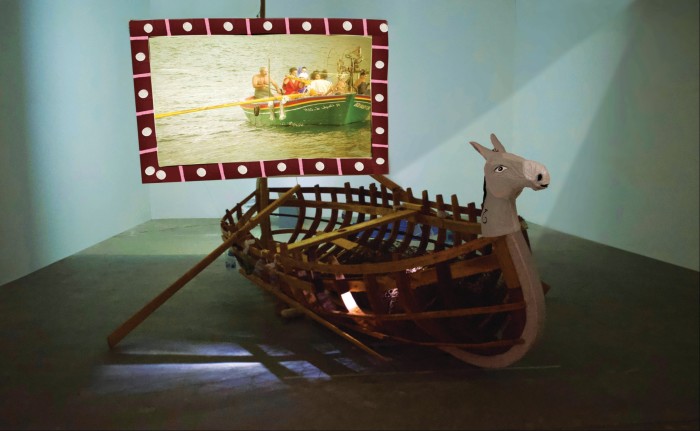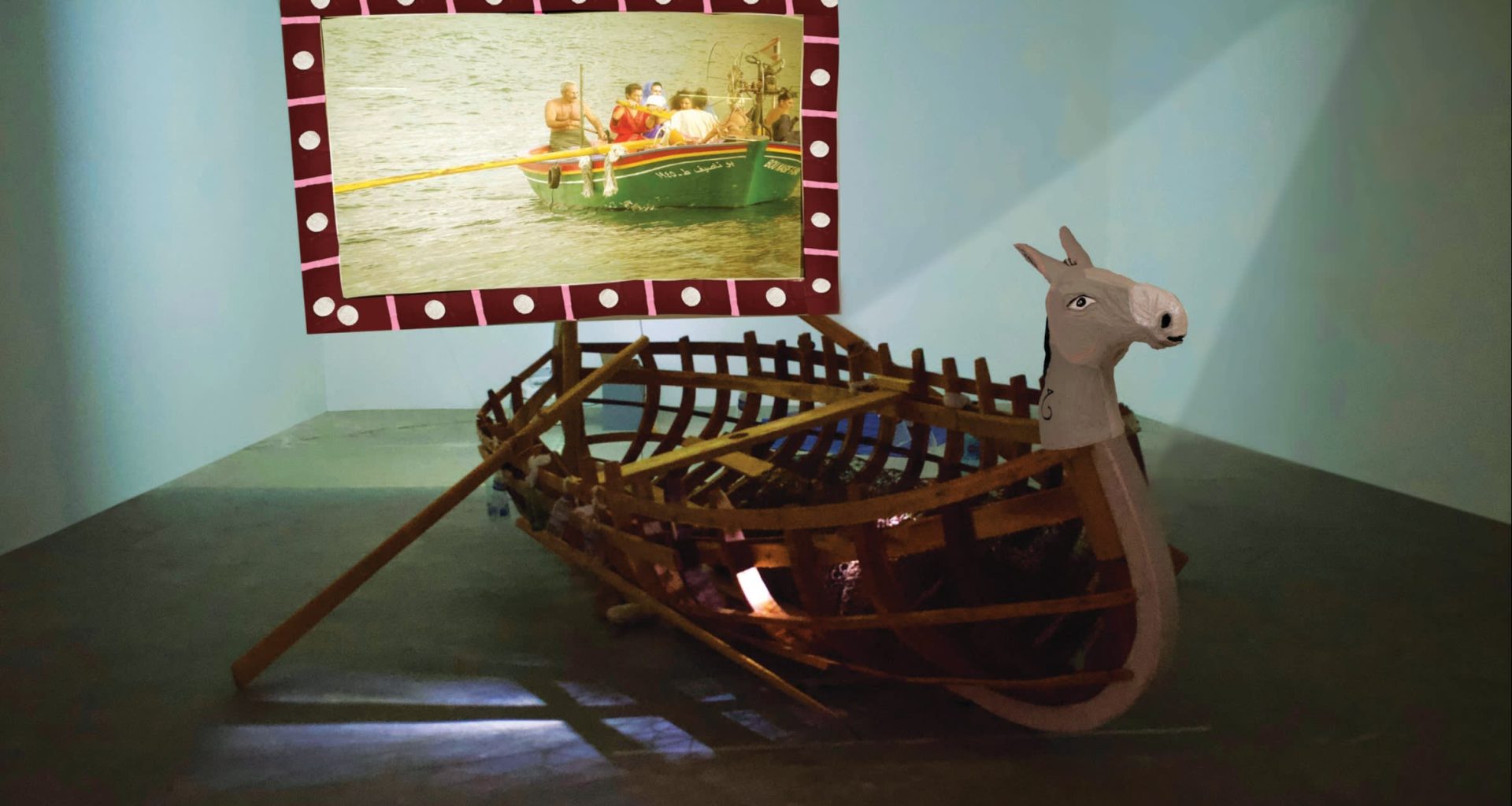Unlock the Editor’s Digest for free
Roula Khalaf, Editor of the FT, selects her favourite stories in this weekly newsletter.
The woman lies on her back, feet in the air. She lazily spins an urn, balanced on her hands, containing a bull’s head. During the 12-minute film in which the bull-twirling goddess appears, a haphazard narrative emerges out of images — many of them animated drawings which boast a frail, enchanting quirkiness — that include lapping waves, dancers in antique robes and onions which weep purple ink. Lines from a poem flash intermittently: “I looked for a magnificent white bull . . . but all I found was a goat.” “I looked for Europa passively carried . . . she held him in a jar.”
The film, which will be projected on to the sail of a wooden boat, is the centrepiece of A Dance with Her Myth, an installation by Mounira Al Solh which will occupy the Lebanese pavilion at the Venice Biennale this year. Its inspiration came from the legend of Europa, the Phoenician princess abducted by Zeus disguised as a bull. Alongside it will be drawings, paintings, sculpture and embroideries.
“Because of corona, because of August 4 [the explosion in Beirut’s port in 2020], we didn’t have the luxury of travelling outside Lebanon for a long time,” says Al Solh when I ask her why she chose Europa’s story. Instead, she and her family took to visiting friends in the north of the country who had an apartment on the coast. “There was the sea wall built by the Phoenicians . . . ”

Al Solh pauses and takes a bite of her chickpea panino. We’ve had a fruitful if unexpected morning. We had arranged to meet at Al Solh’s studio near Arnhem, south of Amsterdam. Al Solh, whose career includes exhibitions in Tokyo, Doha and Chicago as well as participation in Documenta (2017) and being shortlisted for the prestigious Artes Mundi prize in 2023, has been based in the Netherlands for 10 years, although she regularly visits her homeland and keeps her studio practice there.
We had planned that I would see her Venice work in her studio but it had already been shipped to Italy. “The studio is so empty and sad,” she says, although her appearance, in her multicoloured coat and silver loafers with dark curly hair around an open, mobile face, belies her words. Instead, we meet at Amsterdam’s H’ART Museum, where we can see her installation Nami Nami Noooom, Yalla Tnaaam, named after two Arabic lullabies. After seeing the show, a poetic multimedia journey through a childhood marked by Lebanon’s civil war (1975-90), we settle in the museum café.
She returns to the sea wall, which inspired her to excavate the history of the people who dominated modern Lebanon’s coastline in the second and first millennia BCE. “Some people think we should call ourselves Phoenicians rather than Arabs,” she observes.
Known as seafaring traders and inventors, probably, of the first proper alphabet, the Phoenicians had a mythology entwined with that of ancient Greece and Rome, as Europa bears witness. Al Solh decided to focus on the princess because she has been so often eroticised by western male painters, including Titian and Veronese, as a passive victim of male sexuality. “I wanted to reverse that power structure,” exclaims Al Solh. “In my version, she abducts him!”

For Al Solh, the experience of returning to her country’s origins proved restorative. “To look back beyond immediate history was very healing,” she says. She has reason to feel traumatised by Lebanon’s recent past. The civil war claimed 150,000 lives; the 2020 explosion in Beirut’s port not only killed at least 218 people and wounded thousands more but also plunged Lebanon into new political and economic crises. “The mountain shook,” says Al Solh, who was in Beirut at the time of the blast. “Have you ever heard a mountain shake?” She recalls the aftermath as “apocalyptic”. And today, as the Israeli-Hamas war continues to rage, Lebanon’s role as a stronghold of Iran-backed Hizbollah, sworn enemies of Israel, intensifies the country’s vulnerability and divisions.
When many question whether artists should align with nation states at all, did she hesitate before accepting the Venice gig? “Our country is struggling to be a country right now,” she whispers. “Of course, I am not in praise of national pavilions. But whatever you think of your politicians, artists are part of civil society and they need to be heard.” She pauses, then says, wistfully, “But the places we thought were safe are turning against us.”
Al Solh is alluding to the spate of cancellations of pro-Palestinian artists and events by western institutions since Hamas’s attack on Israel on October 7 and the war on Gaza. What is happening is “scary, sad and not acceptable”, she declares. A few weeks later, Al Solh is one of several artists to withdraw from an exhibition at London’s Barbican Centre because it cancelled a lecture critical of Israel.
“Look, I am not militant,” she says, quietly. “During the civil war, I saw terrible crimes committed by both sides. But culture is life! If you cancel it you are lost.”
April 20-November 24, labiennale.org
Read More: World News | Entertainment News | Celeb News
FT










